
Mt. Everest 2002 Expedition
Himalaya - Nepal
29,031.69 feet (8,848.86 m)
Himalaya - Nepal
29,031.69 feet (8,848.86 m)
|
 |
Mt. Everest 2002 Expedition Himalaya - Nepal 29,031.69 feet (8,848.86 m) |
||||||||||
|
|||||||||||
|
I summited Everest on May 21, 2011 and have climbed it three other times (all from Nepal) - 2002, 2003 and 2008 each time reaching just below the Balcony around 27,500' (8400 meters) before health, weather or my own judgment caused me to turn back. I attempted Lhotse twice - 2015 and 2016. When not climbing, I cover the Everest season from my home in Colorado as I did for the 2004, 2005, 2006, 2007, 2009, 2010, 2012, 2013, 2014, 2015, 2016 , 2017, 2018, 2019, a virtual 2020 season, 2021, 2022, 2023, 2024 , 2025 and now the 2026 season.This page is the overview of my 2002 climb.
Climbing Everest in April and May 2002 was one of the most difficult mountains I have ever attempted. While not nearly as technical as Ama Dablam or even the Grand Teton, the combination of altitude, length of the expedition and logistic complexities all conspire to make Everest a significant challenge for any mountaineer. Please see the dispatches I sent during the 2002 climb. I left for Katmandu in late April arriving in Lukla on May 1. We took a full eight days to trek to base camp (BC) stopping in the villages of Packding, Namche, Tengboche, Periche and Gorak Shep. We stayed in teahouses and took day hikes up to 6,000m to acclimatize along the way. 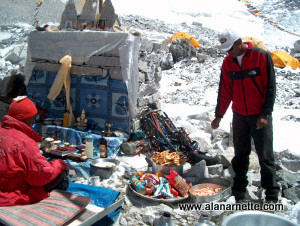 Arriving in BC, the first order of business was the Puja - a ceremony conducted by a local Lama where our team (and climbing tools) was blessed and prayers were chanted all day for our safety. That same afternoon we took our first climb up the icefall to the ladders. Arriving in BC, the first order of business was the Puja - a ceremony conducted by a local Lama where our team (and climbing tools) was blessed and prayers were chanted all day for our safety. That same afternoon we took our first climb up the icefall to the ladders.A short two-hour trip, we practiced walking across deep crevasses on the single length aluminum ladder. It was not nearly as difficult as I had assumed. The next day, we left for 4 nights up the mountain: two at Camp 1 (C1) and two at Camp 2. The Khumbu Icefall is a spectacular mix of snow and ice climbing. It tests every alpine skill in your inventory. This year, 2002, there were about 20 ladders with the longest span being four ten-foot lengths lashed together. They are anchored 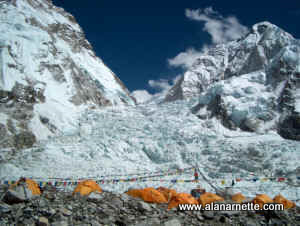 with ice screws and there are usually full length fixed lines on either side for clipping a carabineers into. On our first crossing, one member fell off a ladder and the ropes held him suspended above a 100' crevasse. with ice screws and there are usually full length fixed lines on either side for clipping a carabineers into. On our first crossing, one member fell off a ladder and the ropes held him suspended above a 100' crevasse.It is true what you read about teetering seracs. Throughout the expedition, the icefall moved dramatically required the "Icefall Doctors", Sherpas hired to maintain the ladders, to move them and install new ones for everyone's safety. It was not uncommon to have ladders swaying freely at one end or twisting as you moved across. This was quite unsettling especially when you were tired or the wind was blowing. The icefall became easier as the expedition went on. We took five round trips in total. The first trips were all about getting familiar with the route and the ladders while the last trips involved heavy packs and fatigue, so there was something new every time. The first trip took over four hours to go up while the last trip up took under three. It always took me about three hours to go down since I was very careful about my knees 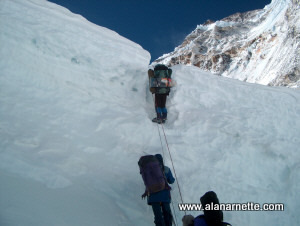 . .C1 was nothing special, a simple weigh station along the way to C2. It was a small community of North Face yellow tents at the first level (and stable) space above the icefall. We spent two nights there. The second day we took a short acclimatization trek half way to C2. It was important not to waste your day away in the tents in order to force your body into making more red blood cells to carry Oxygen further up the mountain. The trip to C2 was across the upper Khumbu glacier. This area is gently sloping upwards towards C2 with several deep crevasses and a few ladders. Most of the crevasses are near C1 and require a down climb of ten to thirty feet then a proportional climb out. Rappelling or abseiling is required on some. This trip can be extremely hot since you are in the middle of the Western Cwm. It was not unusual for the temperatures to reach 100F with direct sunlight that created instant sunburn. Most of us wore a bandanna under our baseball hats to protect our face and necks. 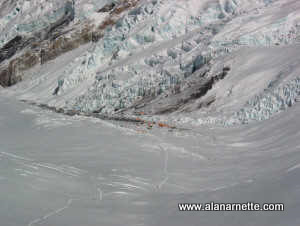 C2 is nestled next to the West Shoulder of Everest and inside a short rock ravine. This is Advanced base camp for every expedition. Most keep full time cooks here which is a nice touch after long days. You can hear the Jet Stream ripping through the spires of Lhotse and Everest. Space is limited here so the expedition camps are placed very close to one another. Here you have an incredible view of the Lhotse face, South Col, Geneva Spur, the Yellow Band and Camp 3. After two nights, we returned to BC for a few days of rest. The next trip we bypassed C1 going directly to C2. C2 is nestled next to the West Shoulder of Everest and inside a short rock ravine. This is Advanced base camp for every expedition. Most keep full time cooks here which is a nice touch after long days. You can hear the Jet Stream ripping through the spires of Lhotse and Everest. Space is limited here so the expedition camps are placed very close to one another. Here you have an incredible view of the Lhotse face, South Col, Geneva Spur, the Yellow Band and Camp 3. After two nights, we returned to BC for a few days of rest. The next trip we bypassed C1 going directly to C2.We experienced a hurricane force windstorm on this trip to C2. The winds blew over 50 m.p.h. for 24 hours straight with gusts over 100 m.p.h. Many expeditions lost entire tents as they blew down the Cwm. Others lost sides of the big diamond shaped tents mostly used for cooking and dining. We were lucky not have any damage due to the heroic efforts of our Sherpas who stood guard all day and night tightening guy lines and literally holding up the cooking tent with their hands during the height of the storm. We hoped to go spend a night a C3 during our second trip to C2 but with the storm and more bad weather forecasted, we returned to BC after spending 5 nights at C2. During this trip we did take two acclimatization climbs up the Lhotse face. The first was less than 1000' up and the second was to 7,000m. Both trips were with light loads but exposed us to the angles and ice on the face. After another few days in BC waiting for the weather to clear and then we went back up to C2. This time we went all the way to C3 and spent the night. At 23,500' we expected not to sleep well and have trouble breathing. Most of us actually did not experience any of these problems. The angle that C3 is pitched on was steep but not overly so. You did have to be careful. There were fixed lines between all the tents, regardless of expeditions, so we clipped in whenever we were out of the tents. Climbing the Lhotse face was the best part of the expedition for me. I found the angles manageable and enjoyable. The downclimbs 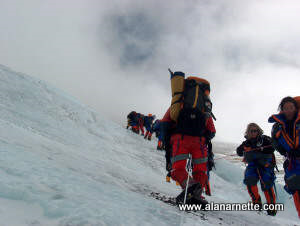 were tough since often you ran into Sherpas coming up thus creating traffic jams where there was only one line. The Sherpas were always polite and accommodating. The surface of snow and ice was very hard and brittle this year since there was not a lot of snow. The first trips up required extensive French step techniques to gain maximum purchase. At the end, after all the traffic, there were decent steps kicked into the ice making it significantly easier. The face is very dangerous no matter the condition. One climber fell to his death while we were there. Reportedly, he was not clipped into the lines and slipped while coming down. were tough since often you ran into Sherpas coming up thus creating traffic jams where there was only one line. The Sherpas were always polite and accommodating. The surface of snow and ice was very hard and brittle this year since there was not a lot of snow. The first trips up required extensive French step techniques to gain maximum purchase. At the end, after all the traffic, there were decent steps kicked into the ice making it significantly easier. The face is very dangerous no matter the condition. One climber fell to his death while we were there. Reportedly, he was not clipped into the lines and slipped while coming down.With our bodies acclimatized, we sat in base camp for 6 days waiting for a weather forecast that showed four days of calm winds before returning. We got it around May 11 and left BC for our summit bid. We spent two nights at C2, with one rest day, and then left for one night at C3. The climb from C3 to C4 was my biggest surprise of the trip. It was long and had some technical parts. The climb out of C3 is straight up the Lhotse face for about 500'. The route turns left and traverses the Face to the Yellow Band. 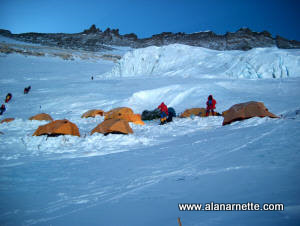 The Band is about 40' of limestone rock that requires concentration. It is not very difficult but is a change from the snow and ice. The Geneva Spur was also a surprise since it was bigger and higher than I expected. The route takes you across the lower part, up a fairly steep section and then requires rock climbing for the last 50'. The entire section slowed everybody down and created long queues at one point. Most everyone was climbing with Oxygen at this point running at 2 liters per minute. We each carried a 3-liter bottle so we had about six hours of O's. Once over this section, it flattens out. After another half-hour we reached the South Col and Camp 4. The Band is about 40' of limestone rock that requires concentration. It is not very difficult but is a change from the snow and ice. The Geneva Spur was also a surprise since it was bigger and higher than I expected. The route takes you across the lower part, up a fairly steep section and then requires rock climbing for the last 50'. The entire section slowed everybody down and created long queues at one point. Most everyone was climbing with Oxygen at this point running at 2 liters per minute. We each carried a 3-liter bottle so we had about six hours of O's. Once over this section, it flattens out. After another half-hour we reached the South Col and Camp 4.C4 is another world. The South Col is wind blown with a layer of hard packed powder and rocks. It sits calmly under the top of the Geneva Spur and, of course, Everest. This is the first clear view of the balcony, South Summit and the summit. Even though these last two are still not in clear view. I was surprised that the route to the balcony was up a 'simple' steep hillside. Ranging from 40 to 70 degrees in angle, it was mostly fixed with rope. There were steps kicked in depending on the terrain. This night there were about 80 people attempting the summit, 54 succeeded.  We were fortunate that there was no wind - no wind, incredible! And the temps were around zero. It was very comfortable in our down suits. We arrived in C4 between noon and two and rested, drank and ate until 9:00. We were woken up by the Sherpas who then took full control. This was where they shined in interacting with us. While they had been working hard for the past five weeks, we saw them occasionally at BC or other camps and spoke with them rarely. However at C4, they knew each of us and called us by name - as we did them. They checked our crampons for tightness, that our harnesses were doubled-backed and that our Oxygen was set properly with the regulators. They helped us on with packs and then lead the climb to the summit. 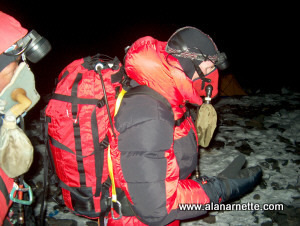 It was obviously dark at 10:30 when we set out. Headlamps lighting up the way, the departure from C4 was like boarding an airplane. Everyone milling around for position and then when one group started, every group started for fear of getting stuck in long lines up the mountain. The frenzy and disorganization was real and alarming considering we had taken six weeks to get to this point! Our team left in small groups, not all together. At this point it felt like 'every person for themselves', except for the Sherpas. Each climber had been assigned to a Sherpa. There was Ang Dorge in the lead, Sherpas assigned to the middle and one bringing up the rear. So actually, each climber had several eyes upon them the entire time. Also each Sherpa and Guide had a radio. We started up the Southeast ridge towards the balcony. The activity was fast paced. Climbers passing climbers. People stopping to adjust Oxygen or gear. The lines took over two hours to spread out. At some points you simply stood in place waiting for the person ahead of you to move, not wanting -or able -to pass them. It was about two hours in that I started to feel worse. Extreme coughing episodes ending with vomiting or gagging. I continued like this over another hour when I concluded that I would never make the summit and going higher would put me, my 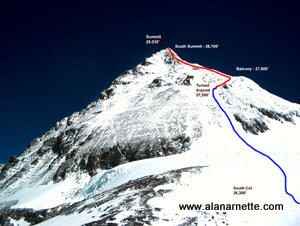 Sherpas and the team at risk. I made the decision to turn around at that point. It ended up that I had contracted a lung infection a few days earlier and it was preventing my lungs from working properly thus causing fatigue and dehydration. Upon my return to BC, three days later, the expedition Doctor heard 'crackling' sounds in my lungs and put me on antibiotics immediately. She also gave me two liters of fluids via IV to get me rehydrated. I was in bad shape as it turned out. Sherpas and the team at risk. I made the decision to turn around at that point. It ended up that I had contracted a lung infection a few days earlier and it was preventing my lungs from working properly thus causing fatigue and dehydration. Upon my return to BC, three days later, the expedition Doctor heard 'crackling' sounds in my lungs and put me on antibiotics immediately. She also gave me two liters of fluids via IV to get me rehydrated. I was in bad shape as it turned out.The trip down from C4 was difficult given my condition. I made the decision to spend a night a C3, very unusual since most Climbers go from C4 to C2 or even BC in one day. I was very weak and did not want to risk making a mistake on the Lhotse face. A little more on the summit attempt as told to me by Haraldur. The trip from the Balcony to the South Summit was longer than he thought it would be but not too difficult. There were queues at the South Summit and Hillary Step while Sherpas fixed lines. About 45 minutes each place. He said the Hillary Step was not bad at all and in fact, easier than the Yellow Band in his view. He said it was a long day, however, very long. I walked out with him and he was tired. That's about it. Incredible journey to a unique place. Deserving of every harsh word ever written or said. AND deserving of all the mystique and attraction. Everest is like a magnet to Mountaineers. Be careful what you wish for... |
|